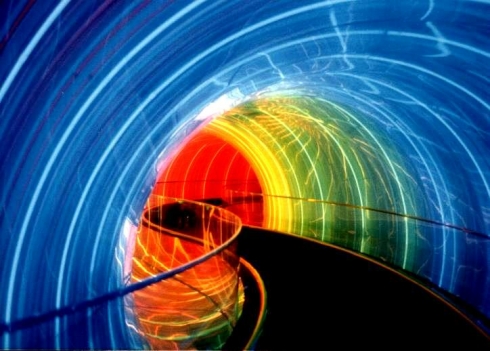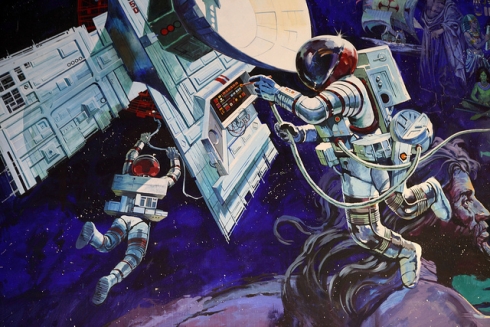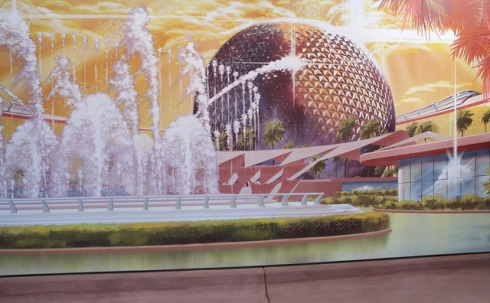3. ImageWorks predicted motion-based gaming
 ImageWorksRainbow Corridor at ImageWorks (Image via Wikimedia Commons, by 10smark)
ImageWorksRainbow Corridor at ImageWorks (Image via Wikimedia Commons, by 10smark)
Back when Figment was Figment and Dreamfinder still existed, Journey into Imagination emptied into ImageWorks, Disney's version of an arcade. Back in the 20th century, it was far different than the version housed in the Imagination! Pavlion today. The exhibits contained within were mostly sensor-driven games and distractions designed to entertain young children – something like a proto-Disney Quest.
The most famous of these was the Rainbow Corridor – a multi-colored plastic tunnel that changed its hue as you passed through it, sensing your body within its space. Other diversions included motion-activated sound effects, tablet-esque drawing terminals, and the “Electronic Philharmonic,” which allowed guests to use hand motions to control a digital symphony (versions of some of these games are actually still playable in the updated Imageworks, although on a slightly smaller scale).
Nowadays, every video game console includes some form of motion gaming. Popularized by the Nintendo Wii, motion gaming forces gamers to use actual, tactile movements to control the action on screen. The Wii uses accelerometers and infrared, the Xbox Kinect uses actual visual recognition, and the Playstation Move uses traditional motion capture. Even mobile games like Fruit Ninja use gesture and movement to control in-game action.
All of these consoles are employing the same concept present in ImageWorks: that humans can interact with digital landscapes through physical motion.
2. Classrooms are now heavily digital
 Spaceship EarthMural at Spaceship Earth (Image via Flickr, by Sam Howzit)
Spaceship EarthMural at Spaceship Earth (Image via Flickr, by Sam Howzit)
Before Spaceship Earth's finale took place entirely on a television screen, your time machine's descent from the stunning planetarium scene included a few actual set pieces. One of those set pieces depicted students in a classroom using a computer to simulate the life of a bug or a trip to another planet.
Sure, it's fantastical, but it's also completely and totally happening in schools today. Not all schools, of course (that's a topic for another article on another site), but some schools are able to offer students these kinds of interactive, tech-heavy learning environments – some even using iPads and laptops to teach subjects across a wide range of media.
Taking a step back even further, the computer itself can become a virtual classroom. Online degree programs are more popular than ever, as are self-taught extracurricular classes in areas such as computer programming or personal finance. Just as the students on Spaceship Earth could create their own lesson using their futuristic classroom computer, students today can create their own curriculum online and learn virtually anything they want.
1. The world is almost completely connected through technology
 EPCOT CenterEpcot Mural (Image via Flickr, by Sam Howzit)
EPCOT CenterEpcot Mural (Image via Flickr, by Sam Howzit)
If you were to craft a thesis statement for Epcot, it might read something like this: The better we are able to communicate with one another in the present, the better the world will be in the future.
Each attraction is, in some way, arguing in favor of that thesis. Spaceship Earth shows how communication brought the species together and helped us evolve to who we are today. The long-departed Horizons told the story of how open communication creates a future full of possibility.
Even modern rides, by virtue of simply being at Epcot, work in concert with this idea. Mission: Space is about teamwork and exploration. Test Track is about innovation and the exchange of ideas. The World Showcase is a physical extension of this theme, bringing 11 countries within close proximity of one another and allowing guests to experience several different cultures at once.
In a way, Epcot is a perfect representation of the internet – a network built on the optimism and the power of open communication. When cultures are closer together, when people feel interconnected, and when everyone is truly looking forward to the future with hope, amazing things can happen. That was the idea behind the World's Fairs of old, it was the idea behind Epcot, and it's the idea behind the vast, open internet we live with today.
So, it's not that Walt Disney Imagineering predicted the rise of the internet, per se; rather, they knew that when people are finally given the chance to communicate without boundary or limitation, changing the world is the easy part.

Comments
Excellent article! I loved the idea of EPCOT's thesis bringing the world together through open communication! It was great up until the last part of the final sentence. I hope in the future we will be able to change the world through open communication, but it is far from easy! Until people across the world accept each other's differences, change will never be easy! It will take a lot more than technology to bring about the acceptance of world-wide diversity! That is my hope for the future!